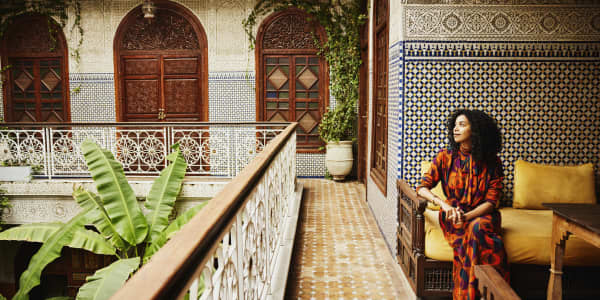Rapa Nui, otherwise known as Easter Island (or Isla de Pascua), is one of the most remote inhabited places on the planet. It's hard to find on a map — the island is little more than a stray dot in the vast southeastern Pacific Ocean. Its closest neighbors are the tiny Pitcairn Islands (some 1,200 miles away), while the nearest continental point is Chile, which is 2,200 miles to the east — or five hours by flight.
Despite its extreme seclusion, most people know of Easter Island for one reason: the moai sculptures. And they are enough to attract nearly 100,000 travelers every year to this island of just 5,700 inhabitants.
Touching down in the middle of nowhere
Approaching by plane, three distinct volcano craters emerge on a triangle of green grass fringed by black coastline. Everything else — in all directions — is barren blue ocean.
Flights arrive at Rapa Nui's small Mataveri Airport in the town of Hanga Roa. The feel here is instantly more Polynesian than Chilean, despite Chile's annexation of the island in 1888.
Aside from the language, imported food and household goods, the connection between Rapa Nui and Chile is obscure. Most of the island's population are of Polynesian descent and many still speak a local dialect, in addition to Spanish. And the most famous inhabitants — the stone-faced moai — have no connection to Chile at all.
The moai of Rapa Nui
Enormous and iconic, the cartoon-like moai statues scatter the windswept island as sentient guardians of the local culture. Their porous, basalt surfaces look featureless and ancient, yet their stature gives them lifelike attributes and a sense there is more to them than meets the eye. After being in their presence long enough, the rock effigies seemingly come alive.
What is surprising is the number of moai on the island, in popular places and lesser-known locations. Seeing the sculptures is simple — visitors can walk right up to them — but touching the moai is strictly forbidden, as they still have great religious significance to the locals.
At Rano Raraku, believed to be the quarry where most of the moai were carved, roped-off pathways lead up the volcanic hillside where hundreds of heads protrude from the soil, complete bodies lean at awkward angles, and ruined or unfinished sculptures lay on their sides. Wandering among the statues reveals subtle differences between them — each one unique in appearance and personality.
Many still wonder how such prodigious statues — which date as far back as the 11th century and range from 3 to 11 meters (10 to 36 feet) tall — were moved to so many locations around the island. Archaeologists and engineers have tried, unsuccessfully, to find the answer. Some people believe it to be the work of aliens from another world. These mysteries add to the moai's enduring allure.
A trio of volcanoes
While the moai tends to dominate international attention, it's Rapa Nui's dramatic coastline that truly mesmerizes.
Jagged volcanic rock forms a crusty perimeter around the island, with inlets that are rhythmically thrashed by the ocean waves. Royal blue water contrasts with brilliant white surf, as tides race in and roar violently against the black cliffs, spraying water high into the air.
There are three principal volcanoes which form the highest points of Rapa Nui, but only one — Rano Kau — can be comfortably reached without a guide. It is home to a small museum and visitor center located in the restored ceremonial village of Orongo.
Beyond the village, visitors can sit on the rim of the volcano for unobstructed views 400 meters (1,312 feet) into the crater. There is also the option to comfortably stroll along the volcano's summit to nearby cliffs that overlook two notable islets — Motu Iti and Motu Nui — that shoot up from the deep sea less than one mile from the shore.
To reach the other two volcanoes, a guide can be easily arranged by most hotels for an even more remote island experience. It's here, in the moments away from other tourists, where you feel alone in a place the rest of the world forgot.
More than just moai
Contrary to common assumption, Rapa Nui is not a beachcomber's paradise. With more cliffs than beaches, the island offers only two choices.
Anakena is the main beach; this small cove of beige coral sand is located next to a park with shacks serving fresh food and drinks. A grassy slope of swaying palms leads to the beach and Ahu Nau Nau, a platform of seven ancient Moai once buried in sand, but which now watch over the bustling bathers below.
The less populated Ovahe Beach is just around the edge of the cove and is a good spot to escape the crowds.
Hiking and biking opportunities on the island are plentiful, each leading to archaeological ruins, more Moai or eye-popping vistas. Guidebooks and maps are useful for self-guided circuits to see the sights by car or on foot.
There are hundreds of underground caves formed by lava flows, a few of which can be safely explored by non-spelunkers. Ana Te Pahu — the largest lava tube on the island — allows more than one kilometer of subterranean exploration. Near the coastline, the 50-meter (164 feet) Ana Kakenga, known as the "cave of two windows," ends at two jagged holes that peer out to the sea.
Despite their popularity and well-marked access, the caves are not for everyone. As paths are slippery and lighting is poor, hiking shoes and a flashlight are recommended for those who want to explore them.
Sunrises and sunsets on Easter Island
A benefit to renting transportation is the ability to witness the remarkable sunrises of Rapa Nui from different points across the island. Each day, visitors and locals alike, make a pilgrimage to the edges of the island to enjoy the magnificence of dawn.
To revel in all of nature's glory, it's best to avoid the crowds at the usual places, such as the remarkable 15 moai platform of Ahu Tongariki, where buses of tourists arrive each morning. Instead, head to a remote oceanside spot to witness the pastel pink sky rise above the sea.
For a nightcap, sunset at the grassy Ahu Akivi — one of the island's few inland moai platforms — offers an inspiring view of seven Moai staring directly into the sinking sun.
Sensational seafood
A benefit to being so far out at sea is the plenitude of fresh seafood. Independent fishermen glide up to the two little wharfs on the edge of town with their daily catch of red kana kana and some of the best deep-water tuna one can find. Visitors can buy fish from the fishermen at modest prices.
Nearly every restaurant serves seafood in some form, including mahi mahi, lobster and even snails from the rocky coastline. The tuna ceviche is not to be missed, with herbs, avocado and meaty cubes of tuna so fresh they're almost crunchy.
For cheaper eats, go for a tuna empanada with its golden crust and perfectly cooked chunks of fish within; they're best bought from food carts on Policarpo Toro Street on the island's waterfront.
Tips
Getting there
Presently, to get to Rapa Nui by air, travelers must either start in Chile or French Polynesia. There are daily flights from Santiago, and one flight weekly from Tahiti, both on Latam Airlines.
Getting around
Rapa Nui can easily be explored independently to fully appreciate both the moai and the island's natural beauty. Navigating is easy, as there is one main road that leads to the most popular archaeological sites. The remaining roads, located along the shorelines and deeper into the island, are primarily made of dirt or gravel.
The best automobile option is an SUV, which are plentiful at the rental agencies in town. Mountain bike rentals and horseback tours are a popular way to explore remote locations such as Maunga Terevaka — the island's tallest volcano — and to visit other places where cars are not allowed.
Renting a four-wheeled ATV gives the greatest access to narrow dirt tracks leading to desolate roads that hug the coastline. There, small ahus (platforms that once supported moai sculptures), scattered remains of settlements, moai ruins and petroglyphs are largely overlooked by tourists and can be explored with nothing but a map and the sound of the sea in the background.
Where to stay
Rapa Nui has a number of intimate luxury hotels, ecolodges and hostels for nearly any taste. For high-end Polynesian comfort, there is the Hangaroa Eco Village & Spa beside the sea or the Explora Rapa Nui in the hills. Other visitors to Rapa Nui opt to rent bungalows or cabanas; they allow for more privacy and space as well as an independent Easter Island experience.





